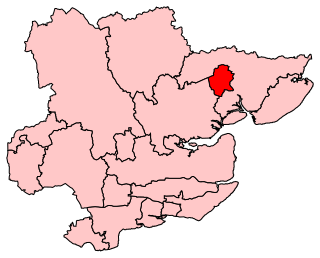Related Research Articles

Colchester is a constituency represented in the House of Commons of the UK Parliament since 2015 by Will Quince, a Conservative.

Abingdon was a constituency of the House of Commons of the Parliament of the United Kingdom, electing one Member of Parliament (MP) from 1558 until 1983.

Petersfield was an English Parliamentary constituency centred on the town of Petersfield in Hampshire. It existed for several hundred years until its abolition for the 1983 general election.
Hertford was the name of a parliamentary constituency in Hertfordshire, which elected Members of Parliament (MPs) from 1298 until 1974.
The UK parliamentary constituency of Seaford was a Cinque Port constituency, similar to a parliamentary borough, in Seaford, East Sussex. A rotten borough, prone by size to undue influence by a patron, it was disenfranchised in the Reform Act of 1832. It was notable for having returned three Prime Ministers as its members – Henry Pelham, who represented the town from 1717 to 1722, William Pitt the Elder from 1747 to 1754 and George Canning in 1827 – though only Canning was Prime Minister while representing Seaford.
Weymouth and Melcombe Regis was a parliamentary borough in Dorset represented in the English House of Commons, later in that of Great Britain, and finally in the Parliament of the United Kingdom. It was formed by an Act of Parliament of 1570 which amalgamated the existing boroughs of Weymouth and Melcombe Regis. Until 1832, the combined borough continued to elect the four Members of Parliament (MPs) to which its constituent parts had previously been entitled; the Great Reform Act reduced its representation to two Members, and the constituency was abolished altogether in 1885, becoming part of the new South Dorset constituency.
Bristol was a two-member constituency, used to elect members to the House of Commons in the Parliaments of England, Great Britain (1707–1800) and the United Kingdom. The constituency existed until Bristol was divided into single member constituencies in 1885.
Sudbury was a parliamentary constituency which was represented in the House of Commons of the Parliament of the United Kingdom.
Ilchester was a constituency of the House of Commons of the Parliament of England, then of the Parliament of Great Britain from 1707 to 1800 and of the Parliament of the United Kingdom from 1801 to 1832. It was represented by two Members of Parliament until 1832. It was one of the most notoriously corrupt rotten boroughs.
Monmouth Boroughs was a parliamentary constituency consisting of several towns in Monmouthshire. It returned one Member of Parliament (MP) to the House of Commons of the Parliaments of England, Great Britain, and finally the United Kingdom; until 1832 the constituency was known simply as Monmouth, though it included other "contributory boroughs".
Portsmouth was a borough constituency based upon the borough of Portsmouth in Hampshire. It returned two members of parliament (MPs) to the House of Commons of the Parliament of the United Kingdom, elected by the bloc vote system.
Lyme Regis was a parliamentary borough in Dorset, which elected two Members of Parliament (MPs) to the House of Commons from 1295 until 1832, and then one member from 1832 until 1868, when the borough was abolished.
Malmesbury was a parliamentary borough in Wiltshire, which elected two Members of Parliament (MPs) to the House of Commons from 1275 until 1832, and then one member from 1832 until 1885, when the borough was abolished.
Wareham was a parliamentary borough in Dorset, which elected two Members of Parliament (MPs) to the House of Commons from 1302 until 1832, and then one member from 1832 until 1885, when the borough was abolished.
Steyning was a parliamentary borough in Sussex, England, which elected two Members of Parliament (MPs) to the House of Commons sporadically from 1298 and continuously from 1467 until 1832. It was a notorious rotten borough, and was abolished by the Great Reform Act.
Plympton Erle, also spelt Plympton Earle, was a parliamentary borough in Devon. It elected two Members of Parliament (MPs) to the House of Commons from 1295 until 1832, when the borough was abolished by the Great Reform Act.
Norfolk was a County constituency of the House of Commons of the Parliament of England then of the Parliament of Great Britain from 1707 to 1800 and of the Parliament of the United Kingdom from 1801 to 1832. It was represented by two Members of Parliament. In 1832 the county was divided for parliamentary purposes into two new two member divisions – East Norfolk and West Norfolk.
Shaftesbury was a parliamentary constituency in Dorset. It returned two Members of Parliament to the House of Commons of the Parliament of the United Kingdom from 1295 until 1832 and one member until the constituency was abolished in 1885.
Charles Churchill was a British Member of Parliament.

Michael Harvey, of Coombe, Surrey. and Clifton Maybank, near Milborne Port, Dorset was a British landowner and Tory politician who sat in the House of Commons between 1717 and 1747.
References
- Robert Beatson, A Chronological Register of Both Houses of Parliament (London: Longman, Hurst, Res & Orme, 1807)
- D Brunton & D H Pennington, Members of the Long Parliament (London: George Allen & Unwin, 1954)
- Cobbett's Parliamentary history of England, from the Norman Conquest in 1066 to the year 1803 (London: Thomas Hansard, 1808)
- J Holladay Philbin, Parliamentary Representation 1832 – England and Wales (New Haven: Yale University Press, 1965)
- Henry Stooks Smith, The Parliaments of England from 1715 to 1847, Volume 3 (London: Simpkin, Marshall & Co, 1850)
- Willis, Browne (1750). Notitia Parliamentaria, Part II: A Series or Lists of the Representatives in the several Parliaments held from the Reformation 1541, to the Restoration 1660 ... London. p. 1.